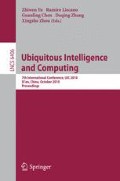Abstract
In this paper, we present a real-time obstacle detection system for the mobility improvement for the visually impaired using a handheld Smartphone. Though there are many existing assistants for the visually impaired, there is not a single one that is low cost, ultra-portable, non-intrusive and able to detect the low-height objects on the floor. This paper proposes a system to detect any objects attached to the floor regardless of their height. Unlike some existing systems where only histogram or edge information is used, the proposed system combines both cues and overcomes some limitations of existing systems. The obstacles on the floor in front of the user can be reliably detected in real time using the proposed system implemented on a Smartphone. The proposed system has been tested in different types of floor conditions and a field trial on five blind participants has been conducted. The experimental results demonstrate its reliability in comparison to existing systems.
Access this chapter
Tax calculation will be finalised at checkout
Purchases are for personal use only
Preview
Unable to display preview. Download preview PDF.
References
Benjamin, J.M., Ali, N.A., Schepis, A.F.: A Laser Cane for the Blind. In: Proceedings of the San Diego Biomedical Symposium, vol. 12, pp. 53–57 (1973)
Davison, A.J., Reid, I.D., Molton, N.D., Stasse, O.: MonoSLAM: real-time single camera SLAM. IEEE Transactions on Pattern Analysis and Machine Intelligence (PAMI) 29(6), 1052–1067 (2007)
Duchon, A.P., Warren, W.H., Kaelbling, L.P.: Ecological robotics. Adaptive Behavior 6(3-4), 473–507 (1998)
Gevers, T., Smeulders, A.W.M.: Color-based object recognition. Pattern Recognition 32(3), 453–464 (1999)
Liebelt, J., Schmid, C., Schertler, K.: Viewpoint-independent object class detection using 3D feature maps. In: Proceedings of IEEE Conference on Computer Vision and Pattern Recognition, CVPR (2008)
Plagemann, C., Endres, F., Hess, J., Stachniss, C., Burgard, W.: Monocular range sensing: a non-parametric learning approach. In: Proceedings of the IEEE International Conference on Robotics and Automation, ICRA (2008)
Saxena, A., Sun, M., Ng, A.Y.: Make3D: learning 3-D scene structure from a single still image. IEEE Transactions on Pattern Analysis and Machine Intelligence (PAMI) 30(5), 824–840 (2009)
Snavely, N., Seitz, S.M., Szeliski, R.: Modeling the world from Internet photo collections. International Journal of Computer Vision (IJCV) 80(2), 189–210 (2008)
Souhila, K., Karim, A.: Optical flow based robot obstacle avoidance. International Journal of Advanced Robotic Systems 4(1), 13–16 (2007)
Sridharan, M., Stone, P.: Color learning and illumination invariance on mobile robots: a survey. Robotics and Autonomous Systems (RAS) Journal 57(6-7), 629–644 (2009)
Tan, C., Hong, T., Chang, T., Shneier, M.: Color model-based real-time learning for road following. In: Proceedings of IEEE Intelligent Transportation Systems Conference, ITSC (2006)
Taylor, T., Geva, S., Boles, W.W.: Monocular vision as a range sensor. In: Proceedings of International Conference on Computational Intelligence for Modelling, CIMCA (2004)
Tola, E., Knorr, S., Imre, E., Alatan, A.A., Sikora, T.: Structure from motion in dynamic scenes with multiple motions. In: Workshop on Immersive Communication and Broadcast Systems, ICOB (2005)
Ulrich, I., Borenstein, J.: The GuideCane-applying mobile robot technologies to assist the visually impaired. IEEE Transactions on Systems, Man, and Cybernetics, Part A 31(2), 131–136 (2001)
Ulrich, I., Nourbakhsh, I.: Appearance-based obstacle detection with monocular color vision. In: Proceedings of the AAAI National Conference on Artificial Intelligence (2000)
The Association for the Blind of WA (2010), http://www.abwa.asn.au
GDP Research (2010), http://www.gdp-research.com.au
Minoru 3D webcam (2010), http://www.minoru3d.com
Currently Available Electronic Travel Aids for the Blind (2010), http://www.noogenesis.com/eta/current.html
Author information
Authors and Affiliations
Editor information
Editors and Affiliations
Rights and permissions
Copyright information
© 2010 Springer-Verlag Berlin Heidelberg
About this paper
Cite this paper
Peng, E., Peursum, P., Li, L., Venkatesh, S. (2010). A Smartphone-Based Obstacle Sensor for the Visually Impaired. In: Yu, Z., Liscano, R., Chen, G., Zhang, D., Zhou, X. (eds) Ubiquitous Intelligence and Computing. UIC 2010. Lecture Notes in Computer Science, vol 6406. Springer, Berlin, Heidelberg. https://doi.org/10.1007/978-3-642-16355-5_45
Download citation
DOI: https://doi.org/10.1007/978-3-642-16355-5_45
Publisher Name: Springer, Berlin, Heidelberg
Print ISBN: 978-3-642-16354-8
Online ISBN: 978-3-642-16355-5
eBook Packages: Computer ScienceComputer Science (R0)

